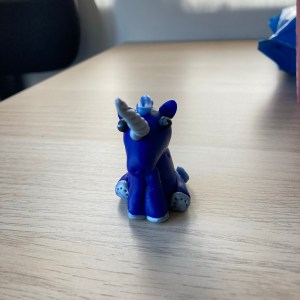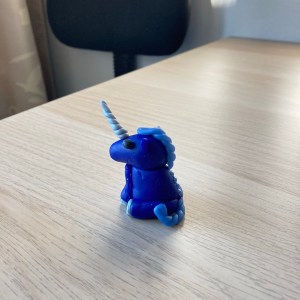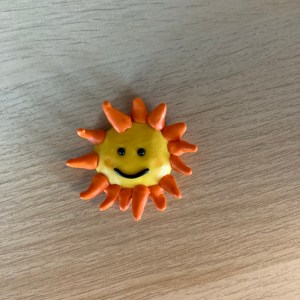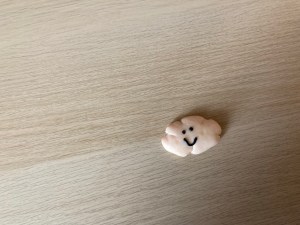Hi everyone. I finally have been motivated to actually make something out of polymer clay again. I guess last Saturday I kicked myself in the behind with my post, saying I fully intended to actually be crafting again rather than just looking at crafty YouTube videos. In fact, these earrings aren’t based on a YouTube tutorial at all. That’s honestly because I still consider the YouTube tutorials a little out of my ability range, but oh well.

I say these are my first proper earrings because I previously, about eight or nine months ago, created a pair of “boiled egg” earrings. I think I showed them here too, but anyway, VoiceOver, the iPhone’s built-in screen reader, guessed that they were two halves of a boiled egg. They were rather ugly in terms of color (yellow in the middle, then white, then purple) but more importantly, I’d glued the earring studs to the polymer clay using a cheap brand of jeweller’s glue. Now for those not familiar with polymer clay: most glues don’t work well with it. Only superglue gel will do and I’ve even heard mixed results about that. Don’t bother with E6000, let alone cheaper glues like the one I used. Bottom line: the earring stud fell off within several hours.
Now on to these earrings I created yesterday. First, I decided to roll out a slab of caramel Fimo with my pasta machine. I had to do this several times over because I kept getting horizontal roller lines in my slab. Finally, once I was satisfied with the result, I cut out the flower shapes. I later learned that it is recommended to lay a piece of copy paper over your slab and lightly roll your acrylic roller over it in all directions. This is called burnishing and should even out any ridges in your slab. I then had my staff poke a small hole into my pieces with a bead piercing pin. This is to guide my drill later on.
Then I baked my pieces at 130°C for 45 minutes. (For those reading the Fimo packaging that says to bake no longer than the recommended 30 minutes, this is flat out wrong.) I baked the pieces on a sheet of parchment paper which I’d put onto my ceramic tile. The oven I use is a convection oven where the fan can’t be turned off, so I had to put an aluminum container over my sheet of parchment paper to prevent it from flying all around the oven. Unfortunately, the parchment paper might’ve flown a little underneath the container, as my pieces did turn out slightly crooked. Either that or I should’ve used copy paper rather than parchment paper, as is recommended by some.
Once the pieces had baked for 45 minutes and then cooled down completely, I drilled the holes into the earrings. I had already decided I wanted to decorate the edges with gold Fimo liquid, but this was my first time drilling actual holes into polymer clay pieces, so I was too curious to see how it’d go to wait till I’d finished the project. I did the drilling mostly independently, only needing my staff to hold down my pieces because I needed two hands to drill.
I then sanded the pieces. There was a bit of a bump on both of my earrings, one bigger than the other. I’m not sure it was an air bubble, as sanding it didn’t leave a hole. I think I did an okay job of sanding them away.
I then decorated the edges with Fimo liquid. I needed some help with this, as of course I’m blind and I cannot feel my way to where I’d need to put the liquid or I’d put it all over my fingers.
Then another round in the oven for 30 minutes (which I’m not sure is enough, but my pieces look fine). Then my staff attached the jumprings and attached those to the earring hooks.
I intend on giving these to my sister when I visit her on Sunday. She’s more of a silvery girl than a goldy one, but I didn’t have silver-colored earring hooks.
Other than the earrings having become slightly curved in the oven, I am relatively content with how they turned out. What do you think?
Linking up with Inspire Me Monday, Busy Monday, Love Your Creativity and the Craftastic Link Party.

















